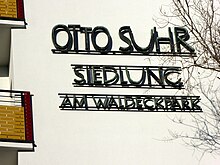Otto Suhr settlement
The Otto-Suhr-Siedlung is a housing estate in the Berlin district of Kreuzberg in the Friedrichshain-Kreuzberg district . It is one of the first demonstrative building projects of the post-war period , which initiated urban renewal in West Berlin , which was characterized by demolition and new construction .
Location and building


Because of the Berlin blockade , building new houses was out of the question until 1949. Public funding for housing - not to mention private capital - was scarce; American financial aid under the Marshall Plan did not start until 1950.
The situation of more or less improvisational financing and insufficient construction activity in West Berlin could only be overcome with the social housing program that began in 1952 . Only with the adoption of the First Housing Act was West Berlin included in the financial system of the Federal Republic of Germany and the distribution of federal funds for housing construction from 1952 . This set the course for the start of reconstruction in West Berlin as well. This type of publicly funded housing construction, which dominates West Berlin, was viewed by the conservative or economically liberal side in misunderstanding its real character as "a quasi-state economic activity of the first order", even as "socialization", the "a new social landscape" create a "society of the classless middle".
The settlement was built on the area on both sides of Alexandrinenstrasse between Stallschreiberstrasse , Oranienstrasse and Waldeckpark in the former Luisenstadt directly on the former border with East Berlin's Mitte district, which was badly damaged at the end of the war . The architect of the first construction phase was M. Rudolph, and the developer was Berliner Wohn und Geschäftsshaus GmbH . The situation at the sector border was intended to demonstrate the intention of the West Berlin Senate to “build towards” the people in East Berlin. After the ruling mayor Otto Suhr (1894–1957) died, the settlement was named Otto Suhr settlement a year later on the occasion of his 64th birthday on August 17, 1958 .
A total of 2300 apartments were built from 1956 onwards. This was done in three construction phases: Part I from 1956 to 1958, Part II from 1959 to 1961 and Part III 1962/1963. According to the memorial plaque, the construction costs for the first construction phase (1280 apartments) amounted to 27.1 million marks (adjusted for purchasing power in today's currency: around 64.6 million euros). The last two skyscrapers were built in 1979. The houses usually have up to eight floors. Some of the houses were grouped around the Protestant St. Jacobi Church . The concept is reminiscent of the concept of the garden city with alternating rows of living spaces and green spaces.
Later situation
The estate was owned by the city and was managed by Bewoge (Berliner Wohn und Geschäftsshaus GmbH), which currently belongs to the Berlin-Mitte housing association (WBM). In 2004, 1,350 apartments were sold to the Apellas fund company, which they resold to Gagfah in 2007 . In 2011 the apartments went to GSW , which was finally taken over by Deutsche Wohnen in 2013 . This mainly affects the houses with arcades . The remaining apartments are still owned by WBM.
Since November 2016, the tenants of Deutsche Wohnen have received modernization announcements for energy-efficient refurbishment , which would increase the rent, which is currently (as of 2017) six euros / m², by up to 40 percent. To counter this, a tenants' initiative has been founded, which is supported by the district council . The WBM apartments are being refurbished with the help of public funds, which means that rent increases will be much more moderate.
See also
literature
- Maria Berning, Michael Braum (eds.): Berlin residential quarters: a guide through 70 settlements. Verlag Reimer, 2003, pp. 174-176.
- Kathrin Chod: Otto Suhr settlement . In: Hans-Jürgen Mende , Kurt Wernicke (Hrsg.): Berliner Bezirkslexikon, Friedrichshain-Kreuzberg . Luisenstadt educational association . tape 2 : O to Z . Haude and Spener / Edition Luisenstadt, Berlin 2002, ISBN 3-89542-122-7 ( luise-berlin.de - as of October 7, 2009).
Web links
Individual evidence
- ↑ a b Dieter Hanauske: housing policy during the Cold War . In: Berlin monthly magazine ( Luisenstädtischer Bildungsverein ) . Issue 3, 2001, ISSN 0944-5560 , p. 35–51 ( luise-berlin.de - here p. 39).
- ↑ About us: Otto-Suhr-Siedlung - The anger is great. In: berliner-mieterverein.de. September 26, 2017. Retrieved December 20, 2017 .
- ↑ Peter Nowak: Deutsche Wohnen Otto-Suhr-Siedlung, How social housing becomes a source of profit. In: peter-nowak-journalist.de. February 10, 2017. Retrieved December 17, 2017 .
- ↑ Ann-Kathrin Hipp: Otto-Suhr-Siedlung: Tenants in Kreuzberg fear displacement. In: tagesspiegel.de . February 9, 2017. Retrieved December 17, 2017 .
- ↑ Residential building in the Otto Suhr housing estate. In: berlin-spart-energie.de. Retrieved December 20, 2017 .
- ↑ Ulrich Paul: Controversial rent increases: Everyone is mad at Deutsche Wohnen. In: berliner-zeitung.de. February 14, 2017. Retrieved December 20, 2017 .
Coordinates: 52 ° 30 ′ 21.4 " N , 13 ° 24 ′ 24.6" E





